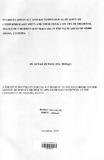| dc.description.abstract | A cross-sectional study was carried out between October 2000 and February 2001 In
three randomly selected slum kebeles of Addis Ababa, Ethiopia. It aimed at providing
information on the nutrient adequacy, bacteriological quality of complementary diets
and their impact on the nutritional status of children aged 6-24 months. The study
covered a total of 350 children. Systematic random sampling was used to select the
study subjects. A structured questionnaire for demographic and socio-economic
information was used for all the study subjects.
The dietary intake of the children was analysed by collecting data based on 24- hour
dietary recall and food intake frequency. Sub samples of the complementary foods
taken randomly from the study households was analysed for possible microbiological
contamination. The study showed that the average income of the household was 250
Birr (29 USD) per month. The proportion of illiterate mothers was found to be 27.3%.
Complementary foods were introduced to the majority (83.4%) of the children at the
age of 4-6 months. Breast-feeding was extended up to the age of 24 months for more
than two thirds (67.5%) of the household children.
The overall rate of malnutrition based on -2SD Z score cut- off point was 26.6%,
38.6% and 9.4% for underweight, stunting and wasting respectively. There was
significant difference (p<O.OI) prevalence of malnutrition in different age groups for
underweight and stunting respectively. The total calorie intake of the children was low
with (15.8%) of male and (19.2%) of female children in the age group 13-24 months,
who met their calorie Recommended Daily Allowance (RDA). A significant difference
(p<O.OI) in energy intake was observed within female and male children.
More than 70% of the children had their protein intake meeting the RDA. Iron and
calcium intake for the children was lower than the recommended intake. The pattern of
nutrient intake got worse as the children grew older.
Coughing and diarrhoea were the major illnesses affecting 28.8% of male and 26.7%
female household children respectively. There was significant difference (p<O.Ol) in the
prevalence of the diseases among the three kebeles Complementary foods were
contaminated by Gram-positive spore formers bacteria (Bacillus subtilis) Gramnegative
organisms, (Klebsiella species, Enterobacter species, E.coli) and molds.
From the review observed in the study it is concluded that the inadequacy of nutrient
intake among the children was due to low intake of essential nutrients and low
diversified diet. .The presence of spoilage and indicator organisms showed the
unhygienic condition for preparation of the complementary foods, which can lead to
infections and worsen the health status of the children.
It is therefore recommended that appropriate use of locally available foods, rruxmg
cereals and legume to balance protein requirement and boost the nutrient intake of the
children. Also income generating activities, appropriate nutrition and health education
for mothers should be promoted. This would improve the nutritional status of the
children and enhance the preparation of microbiological safe foods. | en |

